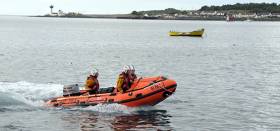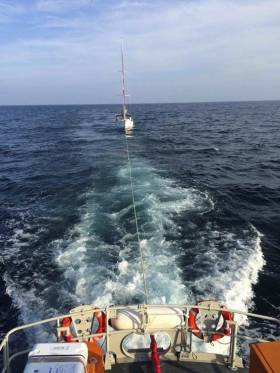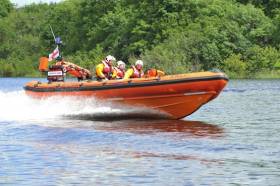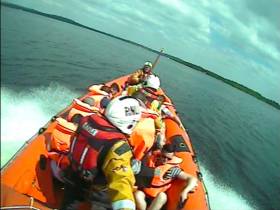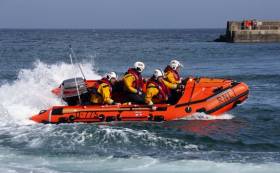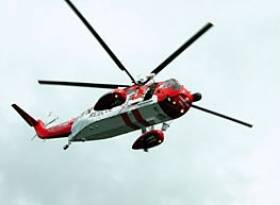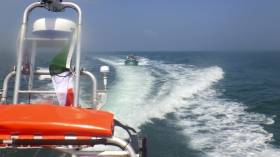Displaying items by tag: RNLI
The RNLI today launches its annual national drowning prevention campaign, Respect the Water, and this year the charity is warning the public to watch out for key dangers that can catch people out in or near water.
The campaign which will run throughout the summer months comes a week after the RNLI, the Coast Guard and Irish Water Safety issued a joint statement advising caution to those engaged in recreational activities in or near water during hot weather as the number of call outs rose sharply.
Respect the Water aims to highlight the risk of accidental drowning when people are near the coastline by encouraging safer behaviour both in and around the water. The campaign is primarily aimed at males aged between 16 and 39 but the same advice is relevant for anyone visiting the coast.
Coastal fatality figures released by the RNLI show that an average of 23 people die through accidental drowning around the coast of the Republic of Ireland each year.
The RNLI has joined with Irish Water Safety and the School of Psychology at the National University of Ireland, Galway, to develop a drowning fatalities database. The work of the group has found that between 2010 and 2013, 70 lives were lost around the coast of the Republic of Ireland through accidental drowning.
The RNLI is warning of the key dangers that can lead to accidental drowning - cold water, unexpected entry into the water, and rip currents and waves.
The campaign will reinforce the key message ‘Treat water with respect, not everyone can be saved’ on a range of channels throughout the Summer. These include a poster showing dramatic imagery of the hand of a drowning person reaching for a lifebuoy and hard-hitting cinema advertisements showing the unpredictability of the water and the dangers of cold water shock.
Speaking as Respect the Water was launched, Joe Moore, RNLI Community Incident Reduction Manager said: ‘We want everyone to enjoy the water. However, it is powerful and unpredictable and people need to treat it with respect. Each year RNLI lifeboat crews rescue hundreds of people around Ireland but sadly, not everyone can be saved. The real tragedy is that many of these deaths could have been prevented.
‘Cold water is a real killer, People often don’t realise how cold our waters can be – even in summer months the water temperature rarely exceeds 12 degrees, which is cold enough to trigger cold water shock. If you enter the water suddenly at that temperature, you’ll start gasping uncontrollably, which can draw water into your lungs and cause drowning. The coldness also numbs you, leaving you helpless – unable to swim or shout for help.
‘The fact that over half of the people who die around our coast each year never planned to enter the water serves as a warning to us all to stay away from cliff edges, particularly where there is slippery, unstable, unstable or uneven ground; stick to marked paths and keep an eye on the water – watch out for unexpected waves which can catch you out and sweep you into the water.
‘If you’re planning to enter the water be aware that, even if it looks calm on the surface, there can be strong rip currents beneath the surface, which can quickly drag you out to sea. The sea is powerful and can catch out even the strongest and most experienced swimmers.’
The charity is asking people to visit RNLI.org/RespectTheWater where they will find information on coastal hazards, how to keep themselves safe, and what to do should they someone else end up in trouble in the water. On social media search #RepectTheWater.
Volunteer lifeboat crew at Larne RNLI responded to a launch request from the UK Coastguard yesterday evening to help search for three overdue divers near Blackhead Lighthouse.
The initial alarm was raised at 5.30pm to report three divers who were 40 minutes overdue. Larne All-weather lifeboat launched followed by Larne inshore lifeboat and the crews were quickly on scene in the Blackhead Area to commence the search. The major multiagency search was coordinated by the coastguard and included Bangor RNLI, the Irish Coast Guard helicopter Rescue 116, four shipping vessels, two boats from Whitehead Yacht club and Larne, Portmuck and Bangor coastguard teams.
The weather conditions of calm seas with thick banks of rolling fog caused poor visibility and challenging search conditions.
Larne RNLI inshore lifeboat located the three divers at 6.50pm on a cliff face north of The Gobbins. The divers were recovered into the lifeboat and did not require medical assistance however they were fatigued, hungry and thirsty. Larne All-weather lifeboat then took the divers onboard and transferred them safely back to Belfast Coastal Operations Centre in Bangor.
Larne RNLI Operations Manager Allan Dorman said 'Conditions were very challenging with visibility down to about fifteen metres. The divers did the right thing and stayed together. We were fearful as time passed and our lifeboat crews were still searching the area with no sightings but thankfully the tide took them north and to nearby rocks. They were exhausted when they were finally located and recovered onto the inshore lifeboat. We are extremely thankful that the callout ended well with everyone accounted for and safely recovered. Our thanks to everyone involved in the search.’
UK Coastguard adds:
Three divers found safe after extensive UK Coastguard search and rescue operation
UK Coastguard coordinated the search and rescue operation for three divers this afternoon who were located by the Larne RNLI inshore lifeboat after nearly two hours in the water.
At 5.30pm today (8 June) UK Coastguard received a call from the coxswain of a RHIB (rigid hulled inflatable boat) dive boat reporting that three divers were 20 minutes overdue from their dive in the area of Blackhead, Belfast Lough.
A Mayday emergency broadcast was issued to alert all shipping vessels in the area and the Ballycastle, Bangor, Larne and Portmuck Coastguard Rescue Teams, the Irish Coastguard helicopter, Bangor RNLI inshore lifeboat and Larne RNLI all weather and inshore lifeboats carried out an extensive search. Four commercial vessels, two fishing boats, a yacht and four RHIBs from the Whitehead Yacht Club responded to the Mayday broadcast and joined the search efforts.
The crew of the Larne RNLI inshore lifeboat spotted the three divers nearly three miles from their original dive location. They were safely put onto the boat and taken to the Bangor Marina where they were met and given safety advice by the Bangor Coastguard Rescue Team. They required no medical treatment.
Ryan Gray, Senior Maritime Operations Officer for the UK Coastguard said: ‘The coxswain of the RHIB dive boat did exactly the right thing calling the UK Coastguard when it became apparent that the divers were overdue. Although we had very heavy fog in the area which reduced visibility, these divers were extremely experienced and had an emergency plan in place when they found themselves in difficulty. It was a very challenging search operation given the weather conditions, however, the divers’ professionalism and the fact that they stayed calm and stuck together, meant that we were able to locate them quickly. They had all the right equipment to cope with this situation and we are extremely glad that they were found safe and well.
‘We would like to extend a massive thank you to all those who reacted quickly to the Mayday broadcast that was issued. It was truly a coordinated effort and everyone did a fantastic job to bring these divers home safely.’
Mr Allan Dorman Larne, RNLI Lifeboat Operations Manager said: ‘Conditions were very challenging with visibility down to about fifteen metres. The divers did the right thing and stayed together. We were fearful as time passed and our lifeboat crews were still searching the area with no sightings but thankfully the tide took them north and to nearby rocks. They were exhausted when they were finally located and recovered onto the inshore lifeboat. We are extremely thankful that the callout ended well with everyone accounted for and safely recovered. Our thanks to everyone involved in the search.’
#RNLI - Bangor RNLI’s volunteer lifeboat crew were called out yesterday afternoon (Tuesday 7 June) to assist in the rescue a woman who had fallen from the coastal path at Ballyholme Esplanade onto the rocky beach below.
The woman is believed to have fallen after the dog she was walking pulled on its lead and she over-balanced and slipped more than two metres to the rocky beach below.
Bangor RNLI relief lifeboat Tabby Cat was launched at 2:20pm and arrived on scene in Ballyholme Bay where NI Ambulance Service paramedics were treating the woman. They were later joined by the fire service and coastguard, who waited on standby in case their services were needed.
After the paramedics had stabilised the woman on the beach and were happy that she could be lifted, the decision was made to move her on a stretcher onto the lifeboat and take her to the jetty at Ballyholme Yacht Club, as this was considered safer than attempting the steps at the esplanade.
At the yacht club, the casualty was lifted up the jetty to the waiting ambulance and taken to Ulster Hospital.
Bangor RNLI helm Micky McKenna said: “The crew and I are delighted to have been able to assist this woman, and we wish her well with her recovery.”
Ballycotton Lifeboat Lauches To Yacht In Difficulty
#RNLI - Ballycotton RNLI was launched around 6pm yesterday (Sunday 5 June) to a yacht in difficulty 10 miles off the East Cork coastal village.
The 50ft yacht, carrying four people on board, got into difficulty when its propeller became wrapped in fishing nets 300 miles off the south coast of Ireland some three days previously.
Due to the calm, mild conditions, the yacht was unable to sail any further and had to call for assistance.
When the volunteer lifeboat crew with Ballycotton RNLI arrived at the scene, they secured the vessel, ensuring all members of the yacht were safe, before taking the yacht under tow to Crosshaven Harbour.
Speaking following the callout, Ballycotton lifeboat mechanic Peter O'Shea said: “Although the yacht was in no immediate danger, its crew kept in regular contact with the coastguard and when they came close enough to land they requested assistance and the Ballycotton RNLI was launched.
"By keeping in regular contact the outcome was positive for all involved and it ended well.”
Open Day At Lough Ree RNLI Next Saturday
#RNLI - Lough Ree RNLI is holding an open day at the lifeboat station at Coosan Point next Saturday 11 June from 12 noon to 4pm.
All are welcome on the day to meet the crew, tour the station, see the lifeboat and join in the fun with face painting, colouring, games, goodies and lots more.
The Lough Ree crew's most recent callout was on Wednesday 25 May, when they assisted eight people on a 48ft motor cruiser that ran aground on a shoal north of Inch Turk.
With no one in any immediate danger and no sign of damage to the boat, the lifeboat crew set up a towline and moved the vessel into safe water, where the engine was started and the steering was checked for damage.
Under their own power, the group of holiday-makers then proceeded towards Hodson Bay. Weather conditions at the time were described as bright with a northerly Force 2 gentle breeze and calm waters.
Speaking following the callout, Lough Ree RNLI lifeboat operations manager Damien Delaney said: "Our lifeboat crew responded swiftly and were happy to assist and bring the vessel into safe water."
At 1.45pm today, Lough Derg RNLI Lifeboat was requested to launch by Valentia Coast Guard, following a request for assistance from a cruiser with 9 people on board, which had grounded on rocks by Ryan's Point.
The lifeboat, with helm Eleanor Hooker, Dom Sharkey and Owen Cavanagh on board, launched at 2pm. Winds were westerly, Force 1/2, visibility was good.
At 2.10pm the lifeboat located the 40ft. vessel by Ryan's Point, inside the Mountaineer navigation mark.
An RNLI volunteer boarded the vessel and reassured everyone, all safe and unharmed, and asked them to put on their lifejackets. The RNLI crew member checked under the floorboards for any damage to the hull and found it intact. He put the ballast tanks on drain and carried out a visual survey of the rocks around the boat.
Meanwhile the lifeboat carried our soundings to determine depths and dangers close to the location. The lifeboat attempted to take the vessel off the shelf from its stern and from the bow, but she was stuck fast. At 3.02pm the lifeboat informed the Coast Guard that it was taking all 9 people and her RNLI crew member onto the lifeboat and transferring the casualties to Dromineer, where they would wait whilst, Lifeboat Operations Manage, Liam Maloney made arrangements for their boat to be re-floated.
On their return passage to Dromineer, the lifeboat had to advise another vessel that they would run aground if they held their course and did not round the Mountaineer Buoy. That vessel changed course and came back out onto the navigation channel.
The lifeboat returned to Station and was ready for service again at 3.40pm.
Lifeboat Operations Manager, Liam Maloney advises all boat users to 'stay within the navigation channels on the lake, and to study your charts before setting out from port'. 'This fine weather is to stay with us a while longer', he continued, 'remember to respect the water and think safety when in or around water'.
Newcastle Lifeboat Launches In Leisure Craft Breakdown
#RNLI - Newcastle RNLI brought two people to safety on Wednesday evening (1 June) after they got into difficulty off the Dundrum coast in Co Down.
The volunteer lifeboat crew was alerted shortly before 8pm following a request by Belfast Coastguard that a vessel with two onboard had broken down in Dundrum Bay.
The inshore lifeboat, helmed by Niall McMurray with crew members Declan Barry and Karl Rooney onboard, launched within minutes to the incident. Weather conditions at the time were described as good with a flat, calm sea.
Once on scene, the lifeboat crew observed that the 17ft leisure craft had experienced engine failure. The crew checked that the two on board were safe and well before establishing a tow line and proceeding to bring the vessel safely back to Dundrum.
Speaking following the callout, McMurray said: "Thankfully both people were not injured and we were able to help bring them safely back to shore.
"We would encourage anyone planning to go in or near water especially during this hot weather spell to enjoy themselves but to always respect the water.
"Check your boat and equipment before every trip, carry a means of communication should you get into any difficulty and always wear a lifejacket."
Coast Guard, RNLI & Irish Water Safety Issue Caution
The Irish Coast Guard, the RNLI and Irish Water Safety advise caution to those engaged in recreational activities in or near water during the current spell of good weather and throughout the summer months.
There has been a significant rise in maritime recreational incidents over the weekend due to the good weather.
At this time of the year as the secondary school term comes to a close and the fine weather is upon us, members of the public are urged to take care when engaging in aquatic activities.
Chief of Operations, Coast Guard Eugene Clonan, said “there has been a noticeable increase in the number of calls over the weekend. Sunday was particularly busy with twenty three calls in response to maritime recreational incidents and he urged members of the public, particularly younger people to exercise caution in and around the water”.
Gareth Morrison RNLI Lifesaving Delivery Manager said, ‘As the weather improves we notice an increase in callouts for our lifeboats. Many of these incidents relate to leisure activities where a nice day out has unfortunately ended in a call for help. Seeking some simple advice before you take to the water or coastline could make all the difference. Our volunteer lifeboat crews are always on call but when every second counts in an emergency you need to be prepared. The RNLI urges everyone to Respect the Water.’
Roger Sweeney, Deputy CEO of Irish Water Safety said that “Ireland averages eleven drownings every month and that constant responsible child supervision will help prevent further tragedies. Parents should check that their local primary school is teaching Irish Water Safety’s classroom based curriculum that instils good habits for a safe summer ahead.”
• The temperature of the sea, lakes, canals and inland water ways is still pretty cold and waters users should exercise caution and be aware of cold water shock and hypothermia.
• Swim with others, never alone, close and parallel to shore.
• If walking on the beach be careful that you are not cut off by the tide. Seek local information about stranding risks.
• Members of the public using recreational craft at the beginning of the season should check the seaworthiness of their craft before launching, particularly engines.
• When departing check the weather forecast, tell someone where you are going and when expected back and wear a life jacket when going afloat.
• For further information on safety on the water check www.safetyonthewater.ie.
• If you see someone in difficulty in the sea, on the shore, cliffs, lakes or rivers dial 999/112 and ask for the Coast Guard.
Motor Boat on Rocks Rescued By Lough Derg RNLI
Lough Derg RNLI launched following a report of a vessel aground at Kylenoe Rocks at the north-eastern end of Lough Derg last night.
At 7.01pm last night Lough Derg RNLI Lifeboat was requested to launch by Valentia Coast Guard, following a report of two adults in difficulty after their 18ft motor boat went aground at Kylenoe Rocks, at the northern end of Lough Derg.
The lifeboat, with helm Eleanor Hooker, Dom Sharkey and Lian Knight on board, launched at 7.15pm. Winds were westerly, Force 2, visibility was good.
The lifeboat located the casualty vessel at Kylenoe Rocks with two people on board, both wearing their lifejackets. An RNLI crew member waded into the boat and reassured the two people on board. The boat had suffered damage to the propeller on their outboard engine, and so they had taken it off the transom and into the boat.
Once the boat was off the rocks and towed into safe water, the lifeboat took it under an alongside tow to Terryglass Harbour, where it was taken out of the water.
The lifeboat returned to Station and was ready for service again at 9.45pm.
Deputy Launching Authority, Brian Hanly advises all bot users to carry a means of communication and 'in case of emergency dial 999 or 112 and ask for Marine Rescue'.
Skerries Lifeboat Tows Motorboat To Safety Off Malahide
#RNLI - Skerries RNLI responded yesterday afternoon (Saturday 28 May) to reports of a motorboat adrift with engine difficulties some four miles east of Malahide Estuary.
Skerries RNLI volunteers launched the lifeboat shortly before 2pm when Dublin Coast Guard tasked them to assist the boat, with four men on board, that was experiencing engine trouble.
Those on board the casualty vessel was able to provide the coastguard with GPS co-ordinates for their position.
As a result the lifeboat, with volunteer Joe May at the helm and crewed by Steven Johnson and Laura Boylan, were able to proceed directly to the vessel.
The motorboat was then taken under tow by the lifeboat and returned safely to Howth. Conditions at the time were clam with a slight sea fog.
Speaking after the callout, Skerries RNLI lifeboat operations manager Gerry Canning said: "Everyone on board was wearing a lifejacket and they were able to give us their exact location. Even the most prepared can encounter difficulties at sea.
"We would just like remind people that if they are in difficulty or see others who may be in difficulty to dial 999 and ask for the coastguard."
Skerries RNLI is currently on the lookout for new volunteers to join its 18-strong crew, as previously reported on Afloat.ie.



























